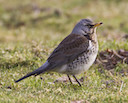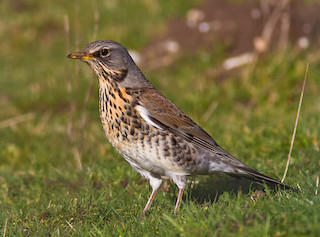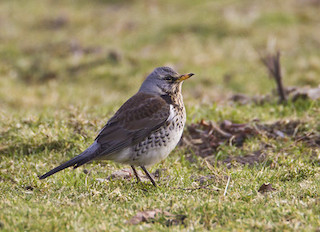 Flocks of Fieldfares can be spotted out on The Lizard through the winter.
Flocks of Fieldfares can be spotted out on The Lizard through the winter.
Photo: © Natural England/Allan Drewitt
Scientific name: Turdus pilaris
Conservation status: IUCN Red List, Least Concern; UK Birds of Conservation Concern, Red.
What to look for:
- Colouring and appearance : Large thrush, standing upright and moving on ground by hopping. Grey head and rump, chestnut-brown back, dark tail, speckled yellowish chest, throat and underparts, yellow-orange beak. Males and females are similar, but the latter have a more brownish colouring on the upperparts.
- Size : Wingspan 40 cm, length 26 cm.
- Where : In fields and woodlands through the winter months. Breeding range extends across northern Europe and Asia.
- Call : Chack chack winter flight call
- Similar species : Mistle Thrush, Redwing
 Winter time is when we welcome Fieldfares to our shores as they come in search of warmer climes than can be found in their Scandinavian breeding territories. Over 650,000 come to visit us in the winter, feasting on autumn berries and invertebrates and roaming the fields and woodlands in loose flocks, often mixed with Redwings, another winter visitor. These noisy flocks sometimes contain several hundred birds, making a memorable sight and sound.
Winter time is when we welcome Fieldfares to our shores as they come in search of warmer climes than can be found in their Scandinavian breeding territories. Over 650,000 come to visit us in the winter, feasting on autumn berries and invertebrates and roaming the fields and woodlands in loose flocks, often mixed with Redwings, another winter visitor. These noisy flocks sometimes contain several hundred birds, making a memorable sight and sound.
Fieldfares breed across northern Europe and Asia in small colonies, building their nests in a tree and defending them aggressively. They have a revolting trick up their sleeve to deter predators: they spray their own faeces at would-be egg-stealers. Both parents feed the chicks after hatching. A very small number of Fieldfares – just a handful each year – breed in the far north of the UK.
 Did you know…?
Did you know…?
…Small birds sometimes choose to nest near Fieldfare nests in order to benefit from the Fieldfare’s voracious protection of its own eggs.
…The common name Fieldfare is Anglo-Saxon in origin and probably means, rather poetically, traveller through the fields.
More information and references:
Svensson, L., Mullarney, K., Zetterstrom, D.,1986. Collins Bird Guide, second edition (translated by Christie, D., Svensson, L.). HarperCollins, London.
Published: December 2015
Author: Amanda Scott
Photos: © Natural England/Allan Drewitt
